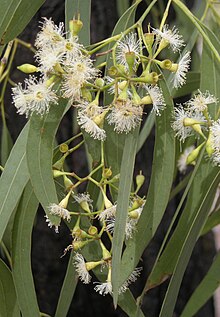Eucalyptus crebra
| Narrow-leaved ironbark | |
|---|---|

| |
| Scientific classification | |
| Kingdom: | Plantae |
| Clade: | Tracheophytes |
| Clade: | Angiosperms |
| Clade: | Eudicots |
| Clade: | Rosids |
| Order: | Myrtales |
| Family: | Myrtaceae |
| Genus: | Eucalyptus |
| Species: | E. crebra
|
| Binomial name | |
| Eucalyptus crebra | |
| Synonyms[2] | |
|
Synonyms
| |
Eucalyptus crebra, commonly known as the narrow-leaved ironbark, narrow-leaved red ironbark or simply ironbark, Eucalyptus crebra is a tree that typically grows to a height of 35 m (115 ft) and forms a 


Description
Taxonomy and naming
Eucalyptus crebra was first formally described in Journal and Proceedings of the Linnean Society, Botany by
Narrow-leaved ironbark has included several species, including E. drepanophylla and E. xanthoclada but these are regarded as
Distribution and habitat
The narrow-leaved ironbark grows in sandy soils in woodland and forest from Picton, southwest of Sydney, north through New South Wales and Queensland to the vicinity of Cairns.[3][4][9]
Uses
The tree has a hard, strong, and dark red timber, which has been used for
Gallery
-
E. crebra open capsules.
-
E. crebra open capsules.
-
E. crebra bark
References
- . Retrieved 18 November 2021.
- ^ a b c "Eucalyptus crebra". Australian Plant Census. Retrieved 16 May 2019.
- ^ a b c d e "Eucalyptus crebra". Euclid: Centre for Australian National Biodiversity Research. Retrieved 4 June 2020.
- ^ a b c Hill, Ken (1999). "Eucalyptus crebra F.Muell". PlantNet - New South Wales Flora Online. Royal Botanic Gardens & Domain Trust, Sydney Australia. Retrieved 2009-06-21.
- ^ Chippendale, George M. "Eucalyptus crebra". Australian Biological Resources Study, Department of the Environment and Energy, Canberra. Retrieved 17 May 2019.
- ^ "Eucalyptus crebra". APNI. Retrieved 16 May 2019.
- ^ von Mueller, Ferdinand (1859). "Monograph of the Eucalypti of tropical Australia". Journal of the Proceedings of the Linnean Society, Botany. 3: 87. Retrieved 17 May 2019.
- ^ Brown, Roland Wilbur (1956). The Composition of Scientific Words. Washington, D.C.: Smithsonian Institution Press. p. 790.
- ^ ISBN 0-85091-213-X.
- ^ "Eucalyptus drepanophylla". Queensland Government department of Environment and Science. Retrieved 17 May 2019.
- ^ D'Hub (Design Hub). "D6911 Timber specimen (plank), Ironbark (Eucalyptus crebra), used in the building of stables at Elizabeth Farm, Rose Hill, New South Wales, Australia, 1793". D'hub - Your online design resource. Powerhouse Museum, Sydney. Retrieved 2009-06-24.[permanent dead link]
- ^ Capilano Honey (2006). "Floral Varieties". Capilano Honey. Capilano Honey. Archived from the original on May 5, 2009. Retrieved 2009-06-24.




